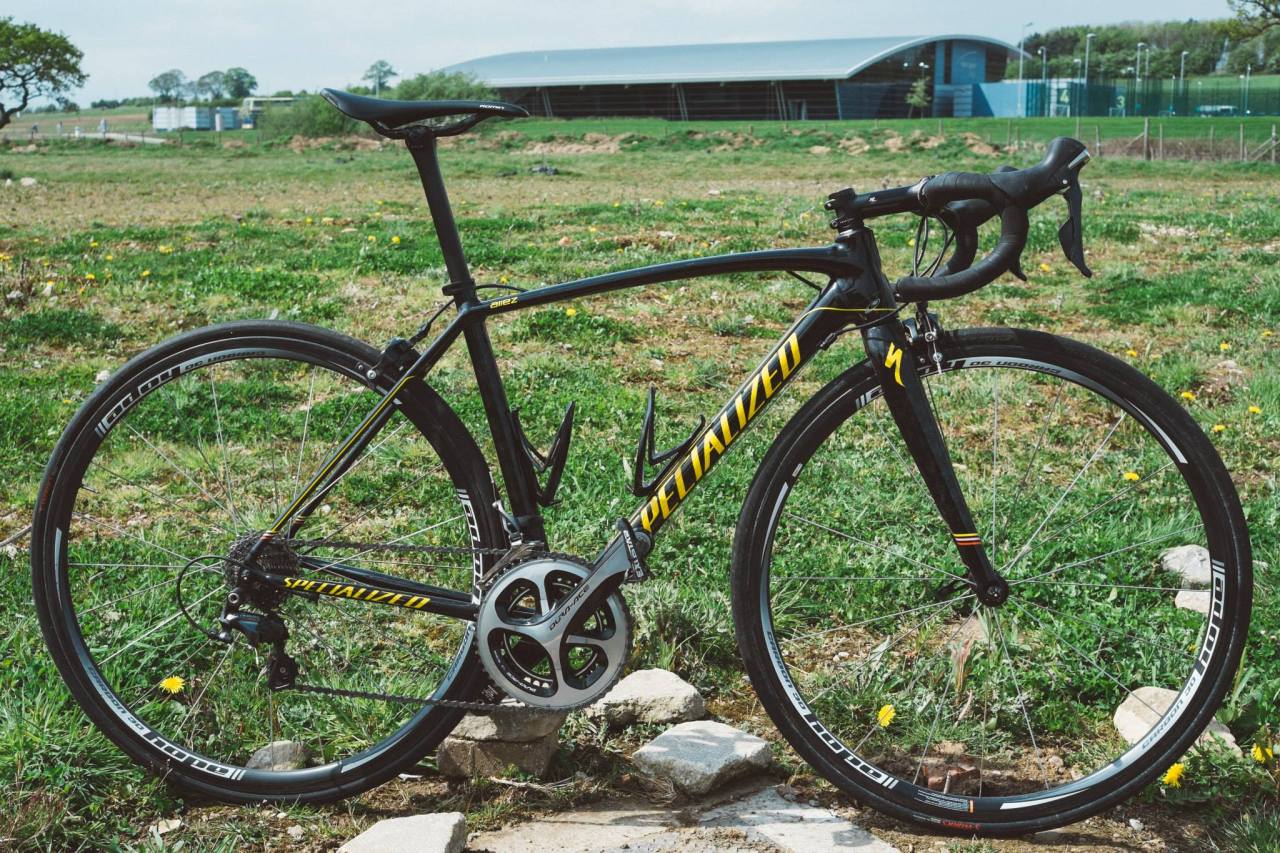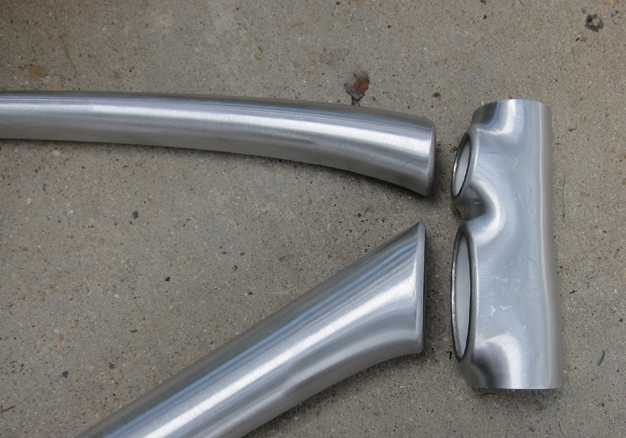This is only going to be a quick one – there’s only so much that can be said about a frameset (outside of the endorsed mainstream reviews you see…).
First a couple of clarifications, this is the frameset only option that retails for approximately £800 in the UK. This is a different frame to the ‘E5 Smartweld’ full bikes you see for £750-1300 as complete bikes. This frameset here replicates the Tarmac SL4’s geometry much closer (and actually shares the Tarmac’s fork). The frameset that comes with the complete build bikes is still a cracking bike though – just ever so slightly less racey.
My version is a custom limited edition paint job, but the standard finish on the bike looks pretty smart too it has to be said! I’ve got it build up with a mixture of ultegra/Dura ace, S-works finishing kit and either Hope carbon 30mm wheels or Hope/Mavic Open Pro 32 spoke wheels depending on the season. This frameset is worth dressing in decent components to get the most out of it!
Now for a bit of sales marketing BS. The ‘DSW’ here stands for D’Aluisio Smartweld. Essentially this frame departs from other aluminium frames in that the welds are behind the stress junctions and welded approx. 10mm behind traditional welds. Moving the weakest part of the bike away from the highest stress area allows for a stiffer, lighter tubeset.
You can see the edges of the tubes are rolled (like the bottom of a Coke can) as a pose to straight as normal. If you try squish the bottom part of a Coke can you’ll notice its incredibly stiff (similarly here the headtube and bottom bracket are very stiff). The rolled edges when put together also create a little crack in which you can fill up with welding. This means after the weld, it all sits flush rather than stuck up like on most frames. This gives the whole frame a very expensive, even carbon like aesthetic. If you don’t let your mates know its aluminium – there’s a good chance they’ll think its carbon!
Or to summarise that last section – Specialized threw in a load of technology unique to them which allowed them to make a stiff, light and really smooth looking bike. At a claimed weight of ~1200g (my 52cm version hovers around 1050-1110g) it’s also equally as light as many carbon options. However you get all the advantages of riding an alloy bike – see my ‘Carbon vs. Alloy’ article for more info on that!
The extra stiff junctions thanks to the DSW technology (see above) mean the middle sections of the tubes can be made thinner making for a more compliant, comfortable bike.
Fit and Finish of the Bike
The finish on the bike is excellent with very scratch and chip resistant paint that looks stunning. The limited edition option is also super nice to have – keep friendly with your Specialized dealer to be kept up to date on limited edition bikes, they’re typically produced in extremely limited numbers.
The full carbon fork borrowed from their Tarmac SL4 is also a quality, lightweight unit. The included headset and seatclamp are the usual quality items to be expected. The alloy seatpost supplied with the frameset isn’t all that light though. I upgraded to the S-Works carbon post to shave some weight and add some comfort – with an RRP for £100 it’s definitely worth it for a top quality post.
{note – I did manage to put a small hairline crack in my carbon steerer of the fork – but Specialized had given me a new one within 3 working days no questions asked}
In the UK, Hope BB30 bearings and Shimano 24mm converters were provided, these have been spot on. Many frames (Cannondale being the big culprit!) have poor quality control on their BB30 shells, giving the preconception that all BB30 bikes have creaky bottom brackets. Certainly in my case this hasn’t been true with an excellent tight fit. The BB30 bearings are still running buttery smooth 4,000 miles later with not a hint of grittiness or drag in them – for BB30 that is outstanding.
The bike has a naturally racey geometry, designed for the racer but also equally suited to the aggressive club rider. One criticism I would have is that the 54cm and 52cm bike have identical reaches (from the BB to the handlebars), which is quite odd. The 54cm has a long effective top tube only due to a more relaxed seat angle. If you’re not sure what this means then don’t worry – it generally won’t affect the fit or feel for many riders, but is a slightly odd choice from Specialized nonetheless.
The bike will gobble up a set of 28c tyres with room to spare – providing the brakes will allow I don’t doubt a 30mm tyre will cause any issues either. This adds a lot of versatility to the frame.
Specialized also back up the frame and fork with a lifetime (of the owner) warranty and Specialized also carry one of the best customer care branches of any bike brand I’ve ever worked with. Warranty claims are always made quickly and without question.
Ride Quality
The bikes super stiff, light enough (7.25kg as pictured) and anyone who’s ridden a Tarmac will know the geometry is super sorted. Carving down hills at daft speeds is easily done with confidence and poise. For whatever can be said about the ride quality of a Specialized – it is impossible to fault their handling characteristics.
The compact nature of the frame (my 52cm measure 48cm from BB to seatclamp) means running more seatpost. This looks nice, but also more exposed seatposts allows for more vertical compliance making for a comfortable ride. Ride quality is equally comfortable to most carbon race bikes, although does carry noticeable buzz over steel, titanium and ‘endurance’ carbon bikes. This ‘buzz’ makes the bike feel electric and alive, certainly not uncomfortable with big hits been damped nicely – but may not be what everyone’s looking for.
Specialized themselves actually claim that the Allez is more vertically compliant and stiffer than their own Tarmac SL4, a highly regarded bike (although not as stiff or compliant as their latest ‘Tarmac’ released in 2015).
What’s it Like Compared to its Rivals?
Compared to carbon? There a few carbon bikes which are lighter, stiffer and more responsive, but the cost is many, many times the cost of this. This also beats a whole load of carbon bikes – far too many to list here. I have had the pleasure of riding most bikes on the market currently though so feel free to leave a comment for specifics! As for Ribble/Planet X carbon bikes, something like this will blow it out of the water in all respects (save weight perhaps). It’ll be stiffer, more comfortable and carry much better aftersales.
It’s main alloy competitors (becoming greater by the year with lots of brands producing quality alloy race bikes now) are the Cannondale CAAD10 (and now CAAD12) and Trek Emonda ALR amongst others.
The Allez and CAAD’s are both racier in offering than the Emonda in terms of geometry (only provided in their more relaxed H2 fit).
Between the CAAD and the Allez they both have their advantages and disadvantages – probably a whole article in itself – maybe I’ll write that one later… (I haven’t ridden the CAAD12 yet, but if its better and lighter than the CAAD10 it’s sure to be excellent).
However to summarise, between them all, they are all excellent bikes and neither a dud. If it were me I’d pick the one a) I like the look of and b) the one that comes from the dealer I most trust. As previously mentioned the Specialized warranty department is much better than Cannondale and much faster than Trek (in the UK) and this alone may sway it for me. But both of the other American giants offer cracking bikes.
Summary
A light, stiff race bike that won’t beat you up on all day rides to rival even the best carbon bikes out there.
The cheaper full build frames stiff offer a quality ride at a decent price and if you don’t fancy building a bike yourself offer great value for money, but for the crème de la crème of alloy race bikes – you won’t go too far wrong with the Allez DSW E5.

